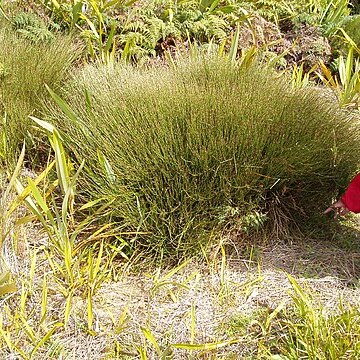Herbs, dioecious or rarely some plants monoecious, perennial, rhizomatous or caespitose, base glabrous or pubescent. Culms simple or branched, glabrous, smooth or minutely rugose. Sheaths persistent, mostly closely appressed, glabrous; lamina terete, erect or reflexed. Inflorescence erect, similar in both sexes; spikelet structure of inflorescences not obvious, subtending bracts similar to upper sheaths, usually shorter than the inflorescence branches. Flowers sessile or shortly pedicellate, with 1 or 2 bracts; tepals 6, glabrous. Male flowers: stamens 3, wholly or partly exserted; filaments free, filiform; pistillode present. Female flowers: tepals similar to males; staminodes present; in Australian species ovary 3-locular and styles 3, free, arising from the outer corners of the ovary summit, style bases persistent, fruit a capsule [or in New Zealand species ovary 1-locular, style 1, fruit either dehiscent (S. ferrugineus de Lange, Heenan & B.D.Clarkson) or an indehiscent nut (S. traversii (F.Muell.) Buchanan)]; carpel margins thickened and pale. Seeds with an irregular network of raised ‘plates’ or ridges over irregularly arranged, ± convex surface cells or with longitudinal lines of convex cells. Culm anatomy: epidermal cells with sinuous walls and globular silica bodies, transverse (horizontal) lines of stomates visible on culm surface, chlorenchyma of horizontal plates of palisade-like cells (2 layers of short cells), pillar cells absent, substomatal cavities lined by protective cells, central cavity angular, (2-or) 3-angled.
More
Plants dioec. Infl. in both sexes a terminal cymose panicle. Glumes scarcely imbricate. Fls ∞, sessile or pedicellate; bractlets 2. Tepals 6, glume-like. ♂ with 3 stamens; anthers 1-celled; ovary rud. ♀ with 3 staminodia; ovary 1-locular; style 1. Fr. a capsule, dehiscing longitudinally. Perennial, rhizomatous, stout. Culms erect, much-branched. Lvs reduced to persistent scale-like sheaths. Monotypic, confined to N.Z.
Moist sites, swamps, bogs, stream banks.

